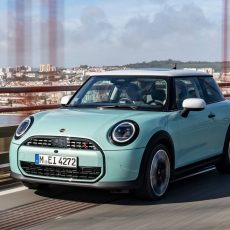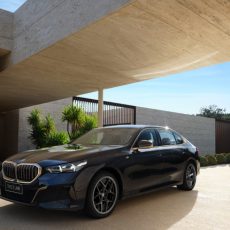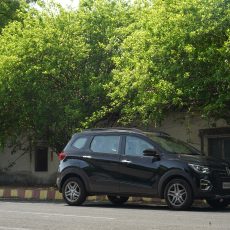The 2022 Audi Q7 55 TFSI quattro is the latest version of the seven-seater Q7 SUV, the model that got the ball rolling for Audi India. Does it still have what it takes to hang with the big boys?

Story: Jim Gorde
Photography: Apurva Ambep
Audi hit it off in the Indian market in a big way with a big offering back in 2007, the huge Q7. The premium crossover SUV of the time combined a high-riding body, seven seats, a potent selection of engines, and the brand’s signature quattro intelligent all-wheel drive. It worked well. Very well.
The Audi Q7 was originally introduced with a 280-hp 3.6 FSI V6 petrol, a more powerful 345-hp 4.2 FSI V8 petrol, and, the most popular choice of the lot, the 240-hp 3.0 TDI V6 diesel. It sold like hot cakes and, soon, Mercedes-Benz, the luxury segment leaders by a huge margin, were seeing their share of the pie diminishing. “Audi” became a new name in the premium luxury space and for good reason. The Q7 was robust, powerful, refined, and spacious. Traits that the new one abides by as well, with a load of technological updates coming in for good measure.
The 2022 Audi Q7 55 TFSI quattro is the sole iteration here. No creamy, screamy V8 and, *sighs in European*, no diesel either. The 3.0-litre, six-cylinder, turbo-petrol has 340 hp and 500 Nm — V8-level output, for sure — and it’s extremely quiet. It adopts a 48-volt mild-hybrid system to help with things including stop/start, energy recuperation, and coasting, all in a quest to maximize efficiency. Does it work? We’ll get to that soon enough.
2022 Audi Q7 – Design and Style
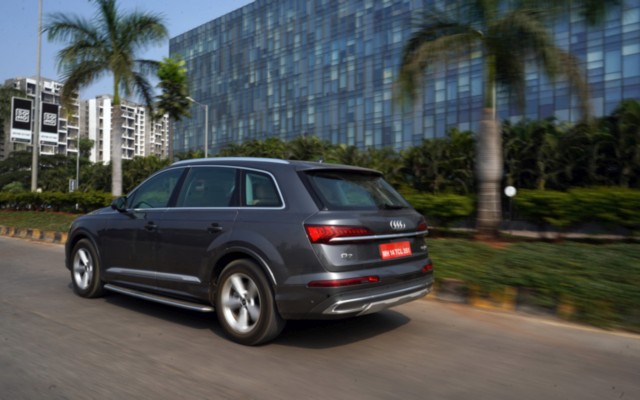
Style is an important aspect for many and this Audi school bus is a huge thing. It measures over 5.06 metres long, is two metres wide, and has a wheelbase five millimetres short of three metres, with massive 19-inch wheels and 255/55 rubber. It looks huge. Even when one takes 15 paces back to try and fit the whole thing into view. It’s big all over and its presence on the road is unquestionable. The new elements do stand out. The aggressive front grille with spaced-out and chromed vertical slats, together with the Matrix LED headlamps and daytime lights give a purposeful stance. It’s a good-looking car. Huge, yes. But it has neat lines and proportions that stand out from some distance away.
2022 Audi Q7 – Interior
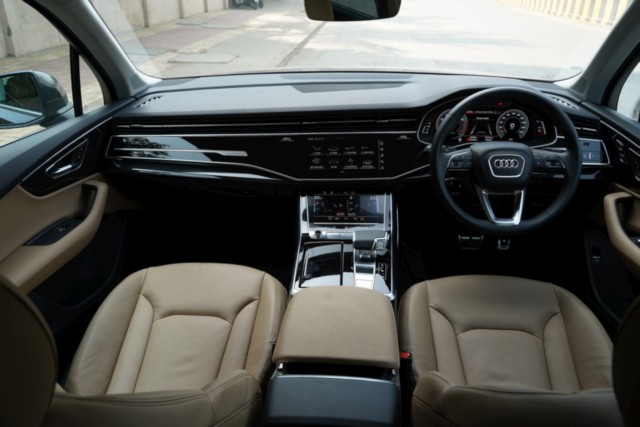
Open the big door and there’s an air of space and functionality. There are choice elements and screens and the interior exudes a practical approach. The MMI (or multi-media interface) with touch controls and huge screen makes it evident that the Q7 is vastly different from its predecessor. It’s been six years since I drove the last one, the 45 TDI with the 3.0 V6 diesel, and it impressed as an all-road all-rounder. The new one has the same vibe. The focus is more on everyday usability than outright luxury and it is evident in the layout and choice of material. The seating is firm and adequately supportive. The three rows of seating, with a 40:20:40 split second row and a powered 50:50 third row, make for immense flexibility. Although the third row has the room for seating two adults, the flat seat base makes it ideal for children rather than grown-ups. Another questionable omission is seat ventilation. Heated seats may work in the cold north and in the EU, but here, in India, it’s a different story.

The highlight of the Q7, however, is its flexibility. The seven seats across three rows, with the second and third rows individually folding down, make for a variety of combinations for people or cargo. The boot holds about 400 litres with the third row up and can expand to over 1,900 litres with the second-row seats down. There are a slew of accessories on offer for managing different load types or segmenting the boot when the third row isn’t in use. Getting into the third row is relatively easy with the fold-and-tumble second row making way. The third-row seats are powered and just need the buttons pushed and held.


